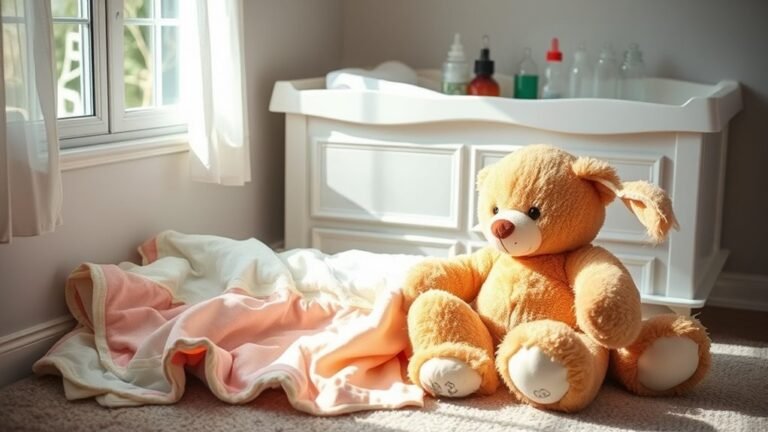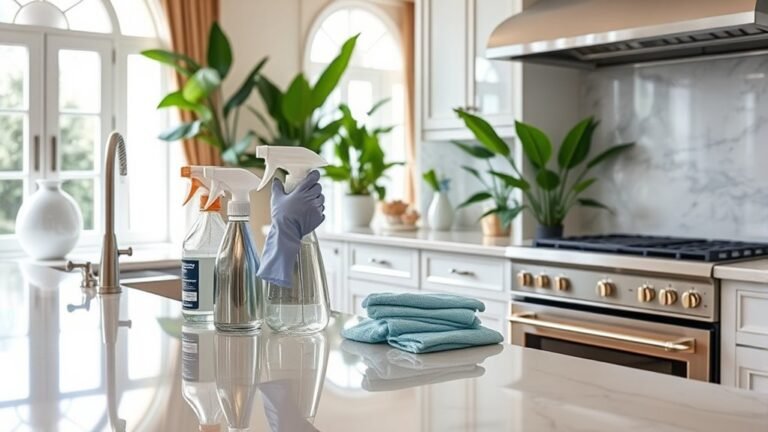Decluttering and Cleaning Your Closet in One Weekend
You can declutter and clean your closet in one weekend by first gathering supplies like boxes and labels, then emptying everything out. Sort your clothes into keep, donate, and toss piles based on condition and use. Next, thoroughly clean shelves, rods, and floors. Organize by category and season, using smart storage solutions like stackable boxes and hanging organizers. Don’t forget to arrange shoes and accessories for easy access. Following simple strategies will transform your closet into a stylish, functional space—keep going for all the tips.
Gather Supplies and Set Up Your Space
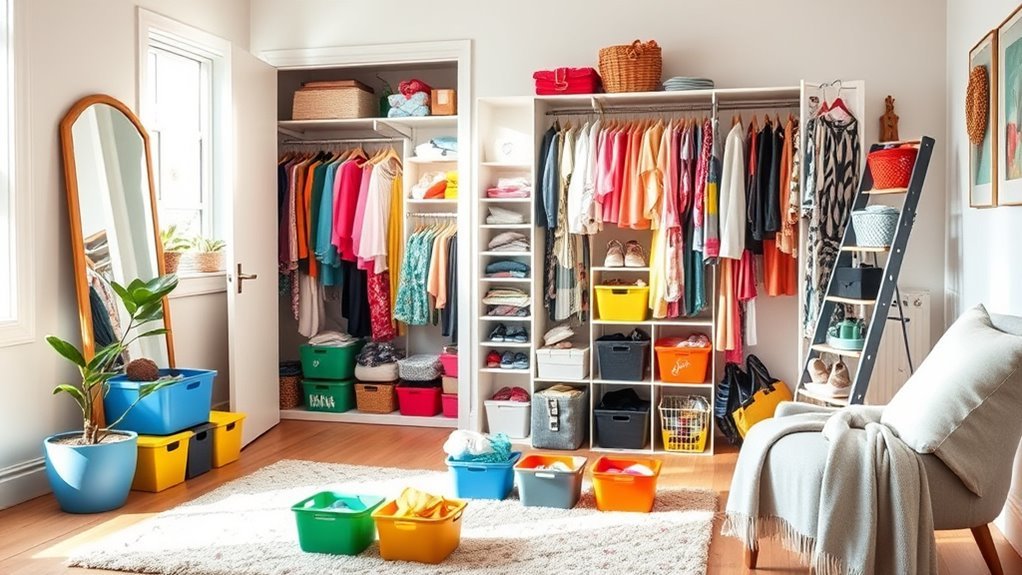
Before you plunge into decluttering, you’ll want to gather all the necessary supplies and create a comfortable workspace. Start with a supplies checklist: sturdy boxes or bins for sorting, trash bags for discards, labels or markers, and cleaning wipes. Having these ready guarantees you won’t get sidetracked searching mid-task. Next, consider your space layout. Clear an area nearby where you can easily sort items into categories like Keep, Donate, or Toss. Make sure the space is well-lit and ventilated, so you feel energized and unrestricted. Setting up this organized environment not only streamlines your process but also fosters a sense of control and freedom. With your supplies and space ready, you’re empowered to tackle your closet without overwhelm.
Empty Your Closet Completely
Start by taking everything out of your closet so you can see all your items clearly. Once they’re out, sort through them in a separate space to decide what to keep, donate, or toss. This clean slate makes it easier to organize and reassess your wardrobe.
Remove Everything First
An empty closet gives you a clear view of everything you own, making it easier to decide what to keep or let go. Start by removing everything first—yes, take it all out. This step helps you create a true closet inventory, letting you see your collection without distractions. You might feel emotional attachment to certain items, but having them all in front of you allows you to confront those feelings honestly. When your closet is empty, you reclaim your space and mindset, setting the stage for freedom from clutter. Only then can you make mindful choices that reflect your current lifestyle and style. So, don’t hesitate—empty your closet completely and embrace the clarity it brings.
Sort Items Outside
Once you’ve emptied your closet, it’s time to sort your items outside of it. Outdoor sorting gives you the space and fresh perspective you need to decide what to keep, donate, or toss. Before you set up, consider weather conditions—choose a dry, calm day to avoid damp or wind blowing your clothes away. Lay out blankets or tarps to protect your items from dirt and damage. Sorting outside also frees you from the confinement of your closet, helping you feel more liberated and clear-headed. This fresh environment encourages you to make decisions that align with your desire for freedom and simplicity. When you’re done, you’ll have a neat pile of essentials ready to return, making your closet truly your own sanctuary.
Sort Clothing Into Keep, Donate, and Discard Piles
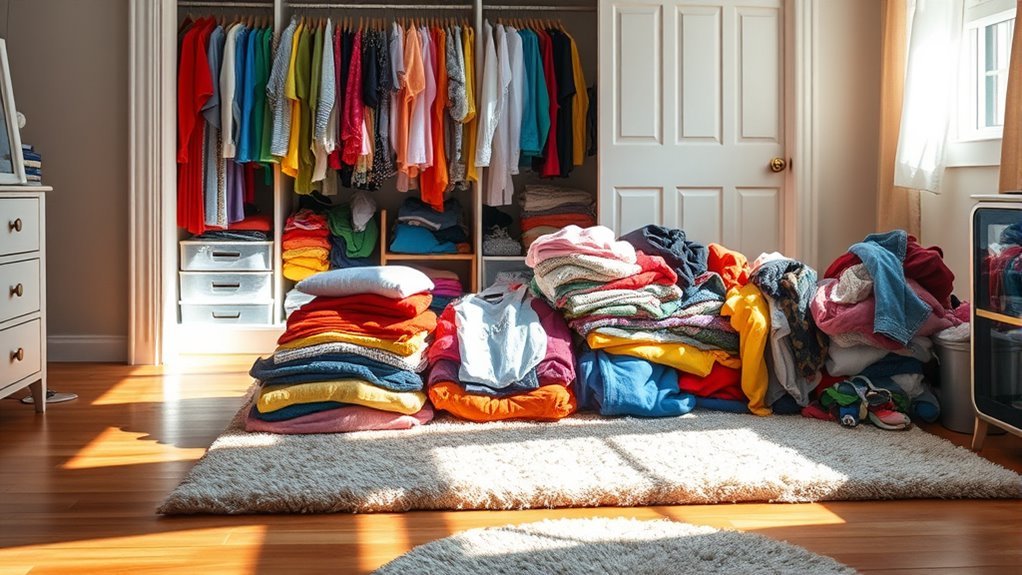
Now that your closet is empty, start sorting your clothes by checking their condition. Decide which items you want to keep, which are good enough to donate, and which need to be thrown away or repaired. This way, you’ll know exactly what stays, goes, or needs a little TLC.
Assess Clothing Condition
Before you start organizing, take a close look at each item to decide whether you’ll keep it, donate it, or discard it. Assess the clothing quality carefully—check for stains, tears, or fading that might make the piece less wearable. Consider fabric types too; delicate materials like silk may need special care, while sturdy cotton or denim might last longer. If an item no longer fits your style or comfort, it’s okay to let it go. Keeping only what truly serves you creates space for freedom and ease in your daily routine. Remember, the goal is to surround yourself with clothes that feel good and reflect who you are. This honest assessment is key to a closet that supports your lifestyle without clutter.
Identify Donation Criteria
After evaluating your clothing condition, the next step is to clearly define how you’ll sort each item. This process sets you free from clutter by deciding what stays and what goes, guided by donation guidelines that charitable organizations recommend.
- Keep items you love, fit well, and wear regularly—freedom starts with what suits you.
- Donate gently used pieces that are clean, intact, and seasonally appropriate for charitable organizations.
- Discard worn-out or stained clothes beyond repair to avoid adding burden to donation centers.
- Respect specific donation guidelines by checking what local charities accept to guarantee your generosity makes a positive impact.
Separate Repairable Items
A crucial part of decluttering your closet is separating items that need repairs from those you’ll keep, donate, or discard. Take a close look at each piece and set aside anything with minor damage, like loose buttons or small tears. These items deserve a second chance through simple repair techniques that don’t break the bank. Whether it’s sewing on a button or patching a hole, choosing cost effective solutions helps you avoid unnecessary spending while extending your clothing’s life. This way, you’re not just clearing space—you’re freeing yourself from waste and embracing a more intentional wardrobe. By sorting your repairable items, you regain control over your closet and create room for pieces that truly serve your style and lifestyle.
Clean Shelves, Rods, and Floor Thoroughly
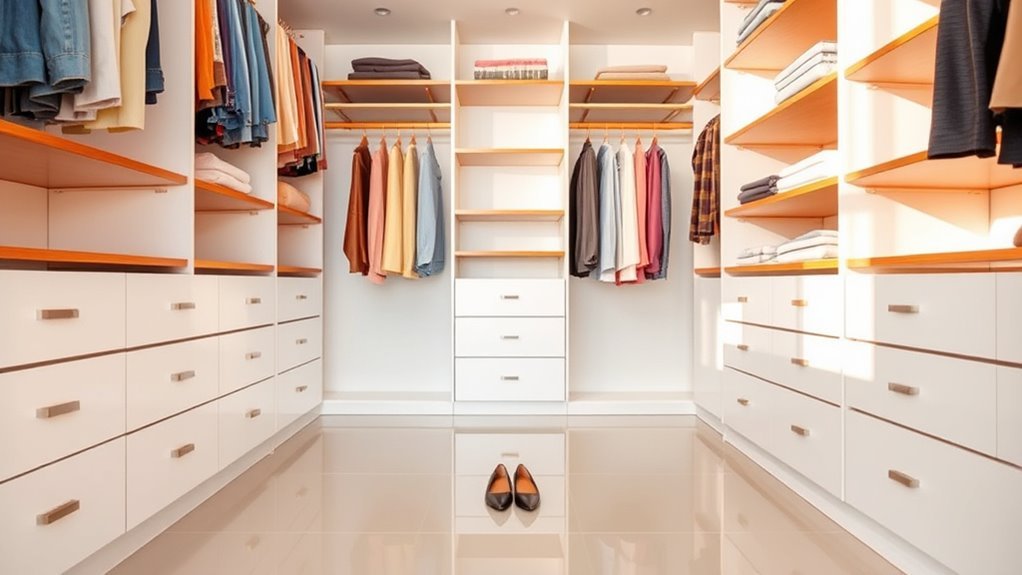
Scrub every shelf, rod, and floor space in your closet to create a fresh, clean foundation for your belongings. This step frees you from lingering dust and grime, making your space inviting and ready for organization. Use effective cleaning techniques like a gentle all-purpose cleaner and microfiber cloths to protect surfaces while removing dirt. As you clean, envision the freedom that comes from a tidy area.
- Remove all items to access every corner.
- Dust rods and shelves thoroughly, reaching high and low.
- Mop or vacuum the floor, focusing on corners.
- Let everything dry completely before returning your belongings.
This clean slate empowers you to use organizational tools more effectively, setting you up for lasting order and freedom in your closet.
Assess Your Storage Solutions
Before you start putting things back, take a close look at your current storage solutions to see what’s working and what isn’t. Your closet layout should support easy access and clear visibility, freeing you from daily frustration. Ask yourself: Are your shelves holding everything neatly, or do items pile up? Do your storage options maximize space or create clutter? You might find that adding baskets, dividers, or adjustable rods could transform your setup. Remember, a functional layout isn’t about fitting everything in but about creating freedom to find what you need quickly. If something feels cramped or inefficient, don’t hesitate to rethink or upgrade your storage options. This thoughtful assessment will set the stage for a more organized, liberating closet experience.
Organize Clothes by Category and Season
Three simple categories—tops, bottoms, and outerwear—can make organizing your clothes much easier. By embracing category grouping, you create a system that frees you from clutter and chaos. Seasonal rotation helps you keep only what’s relevant within easy reach, giving your closet breathing room.
- Separate your clothes into those three categories for clarity.
- Within each category, divide items by season—spring/summer and fall/winter.
- Store off-season clothes elsewhere to maximize space and focus.
- Regularly review and rotate your clothes; this keeps your wardrobe fresh and manageable.
Use Storage Containers and Dividers Efficiently
Once you’ve sorted your clothes by category and season, it’s easier to see where storage containers and dividers can help keep everything neat. Choosing the right storage solutions allows you to maximize space while maintaining freedom to access what you want quickly. Clear plastic bins are perfect for visibility, while fabric containers add a softer touch and protect delicate items. Drawer dividers help separate smaller pieces like socks or scarves, so you don’t waste time digging through clutter. Consider container types that fit your closet’s size and style—stackable boxes save floor space, and hanging organizers free up shelves. Using these smart storage solutions guarantees your clothes stay orderly, making your closet feel open and inviting instead of cramped and chaotic. You’ll love the ease and freedom this brings to your daily routine.
Implement a System for Shoes and Accessories
When organizing your closet, you can’t overlook shoes and accessories since they often create clutter if left unmanaged. To enjoy true freedom in your space, you need a reliable system for shoe organization and accessory storage. Here’s how to start:
- Sort shoes by type and frequency, then store them where you can easily grab your favorites.
- Use clear, stackable boxes or open racks to keep shoes visible and accessible.
- Dedicate small containers or trays for accessories, preventing them from scattering.
- Hang scarves, belts, and jewelry on wall-mounted organizers to save space and add style.
Maintain Your Closet’s Organization Moving Forward
Keeping your shoes and accessories neatly arranged is just the start; sustaining that order takes ongoing effort. To keep your closet feeling like a sanctuary, develop simple maintenance habits. Set aside a few minutes each week to tidy up, return items to their places, and reassess what you truly need. Seasonal assessments are key—every few months, evaluate your wardrobe to remove pieces you no longer wear and swap out seasonal items. This not only frees up space but guarantees your closet stays aligned with your lifestyle. By embracing these small, consistent actions, you’ll enjoy a clutter-free closet that supports your desire for freedom and ease, turning organization into a natural part of your routine rather than a chore.
Häufig gestellte Fragen
How Do I Decide What to Keep if I’M Emotionally Attached?
Think of your emotional attachment like a tangled vine; it can both support and suffocate. When deciding what to keep, use decision making strategies like asking if the item brings joy, serves a purpose, or reflects who you are now. Don’t hold onto the past out of guilt. Instead, focus on freedom—choose items that uplift and empower you, helping you create space for new experiences and growth.
What’S the Best Time of Year to Declutter My Closet?
The best time to declutter your closet is during spring cleaning when you’re already in the mindset to refresh and renew. It’s the perfect moment to switch out your seasonal wardrobe and let go of clothes that no longer serve you. You’ll feel lighter, freer, and more in control of your space. Tackling it then helps you embrace the new season with a closet full of only what you truly love.
Can I Use Digital Tools to Help Organize My Wardrobe?
Imagine opening your closet and instantly knowing every piece inside. You can totally use wardrobe apps to create a digital inventory, snapping photos and categorizing your clothes effortlessly. These tools free you from the chaos, making it easy to plan outfits or decide what to keep. With just a few taps, you’ll gain clarity and control, turning your wardrobe into a seamless extension of your lifestyle.
How Do I Handle Sentimental Items That Don’T Fit Anymore?
When handling sentimental items that don’t fit anymore, focus on memory preservation without feeling weighed down. You don’t have to keep everything physically; consider taking photos or creating a digital scrapbook to hold those memories. This way, you maintain emotional balance while freeing up space. Let go of guilt by remembering the freedom you gain, knowing your memories aren’t tied to clutter but live on in meaningful ways.
What Are Eco-Friendly Ways to Dispose of Unwanted Clothes?
You don’t have to toss unwanted clothes in the trash. Instead, try upcycling clothes by turning them into new items like tote bags or cleaning rags, giving them a fresh purpose. If that’s not your style, look for textile recycling programs nearby—they’ll transform fabrics into insulation or other materials. These eco-friendly options help you reduce waste while freeing yourself from clutter in a way that respects the planet.





